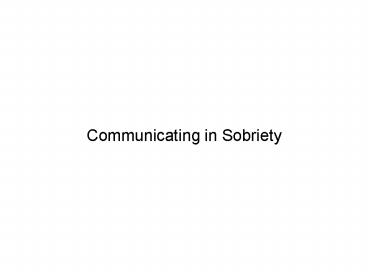Communicating in Sobriety PowerPoint PPT Presentation
1 / 11
Title: Communicating in Sobriety
1
Communicating in Sobriety
2
A Treatment Goal
One of the hopeful outcomes of treatment is that
we learn to identify our feelings but its not
enough just to know how we feelwe also have to
be able to communicate our thoughts, feelings and
needs. Basically our methods of
behaving/relating/communicating come out in four
different ways These behaviors are described as
ASSERTIVE, PASSIVE, HOSTILE and
PASSIVE-AGGRESSIVE. Obviously the last two are
negative behaviors, and even though we learn our
behaviors largely from our families of origin,
treatment provides you with enough information
and insight for you to realize that You dont
have to let negative behaviors control you. You
can make conscious choices about how you act
towards others. Exercising these choices ,
strangely enough, become the result of your
powerless ness (realizing the need to give up old
behaviors and the turning over of the old self)
while providing you with personal empowerment
3
- What Is Honest Communication?
- Honest communication is communicating without our
old agendas (usually control and manipulation)
Its what allows us to ask for information, or
what we need, or share how were feeling. Its a
powerful tool in creating intimacy. - Through honest communication we can lean to
- Explore our own feelings
- Express our feelings to others
- Trust ourselves
- Ask for what we want
- Cope with anger
- Enjoy sobriety
What is Honest Communication?
4
Take a Look at Passive Behaviors
- Weak handshake
- Timid Affect
- Poor, slouching posture
- Soft voice
- Terrified of anger
- Self-focused anger causes depression
- Sees criticism as disapproval
- Reacts toward criticism with
- self doubt
- self loathing
- self punishing behavior
- Values others judgment more than own
- Looks constantly to others for approval
5
Passive Behaviors (cont)
- A passive personality fears rocking the boat
- Tries to get what he wants through manipulation
of others, by making them feel - 1. Responsible for his/her happiness
- 2. People should know what he/she wants without
asking for it - 3. Guilty
- Plays the martyr
- Sees himself/herself only as he/she imagines
others see him/her
How We Become Passive
Sometimes as children were told to be good,
meaning dont ask questions dont bother me,
dont make waves. If that gets us approval as
children we may learn to use passive behaviors.
Unfortunately, ultimately, we pay for it with
self respect.
6
- Characteristics of Hostile Behavior
- No consideration of others
- Talks over others poor listener
- Constantly frustrated from unsuccessful attempts
to - control others
- Extremely judgmental, putting others on the
defensive - Reacts to criticism aggressively/defensively
- Does not respect the opinions of others
- Does not askdemands
- Sees himself as uniquely important
- Such behavior develops in responsive to having
been treated badly, not affirmed, listened to,
etc. It is a survivalist tactic in some
dysfunctional families. Guaranteed to cause
relationship problems in recovery.
7
Passive-Aggressive Behavior
- If a person is angry and is too afraid (or
uninformed) to act on that anger appropriately,
the behavior is called passive aggressive - It is indirect anger or anger that comes out
sideways. - Examples
- The angry husband who keeps forgetting to put gas
in the car when he knows his wife will be driving
it next - The mother who feels completely unappreciated b
her childrenand completely forgets to pick them
up at the park - Setting up another person to fail, look bad etc.
when theres no way you can be found out. - Usually this behavior is learned by imitation,
especially if its seen as being effectively used
by one or the others parents
8
Assertive Behavior
- Communicates openly and honestly
- Handles anger with complete honesty
- Looks at criticism with reasonable emotion (less)
- Values his judgment highly but views situation
realistically - Accepts responsibility for his own actions
- Uses his intelligence to study the issue
- Does not see denial of a request as rejection
- Knows that a healthy and realistic self-image is
important to sobriety - An assertive person acts in his own best intersts
and wants to control only his own actions
9
In Changing Your Communication Style
- Change involves an awareness of how you presently
communicate - To be integrated, or congruent, or mature, or
put together what youre feeling and what
youre communicating should be similar
10
Is the Cheese displaying passive or aggressive
behavior? How would you describe the Farmers
behavior?
11
Communication Worksheets
- What is the physical look of hostile
communication? - What is the physical look of assertive
communication? - List five personal examples of your passive
behaviors. - List five examples of your hostile behaviors.
- Give an assertive way of dealing with each of
your passive and hostile behaviors. - What personally would you like to work on in your
communication?

